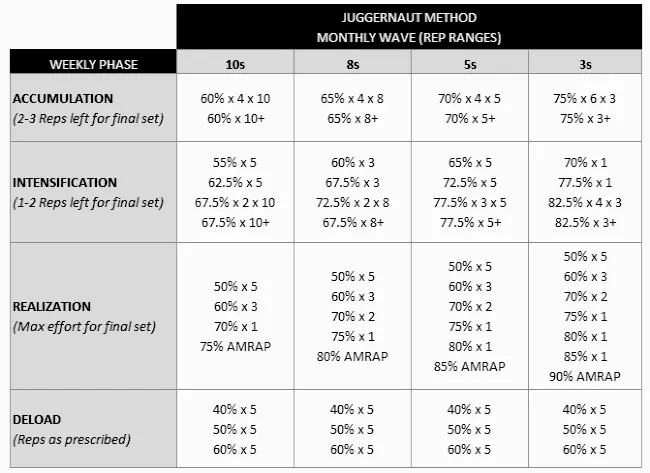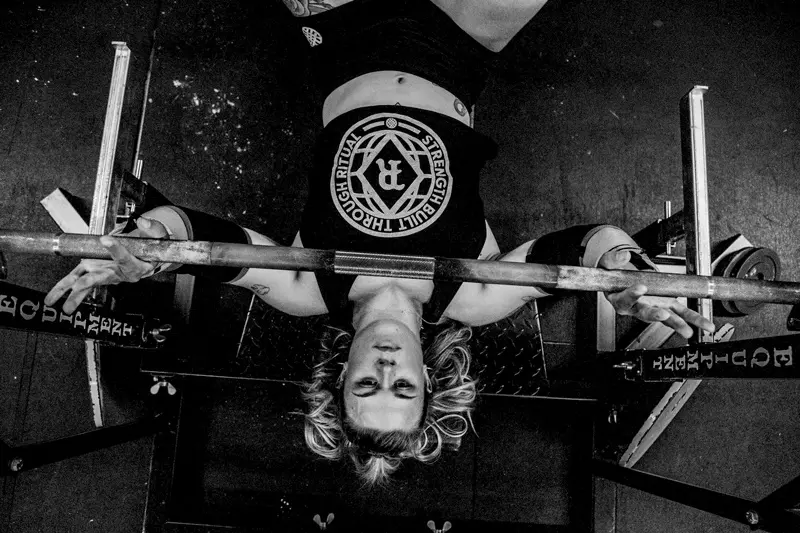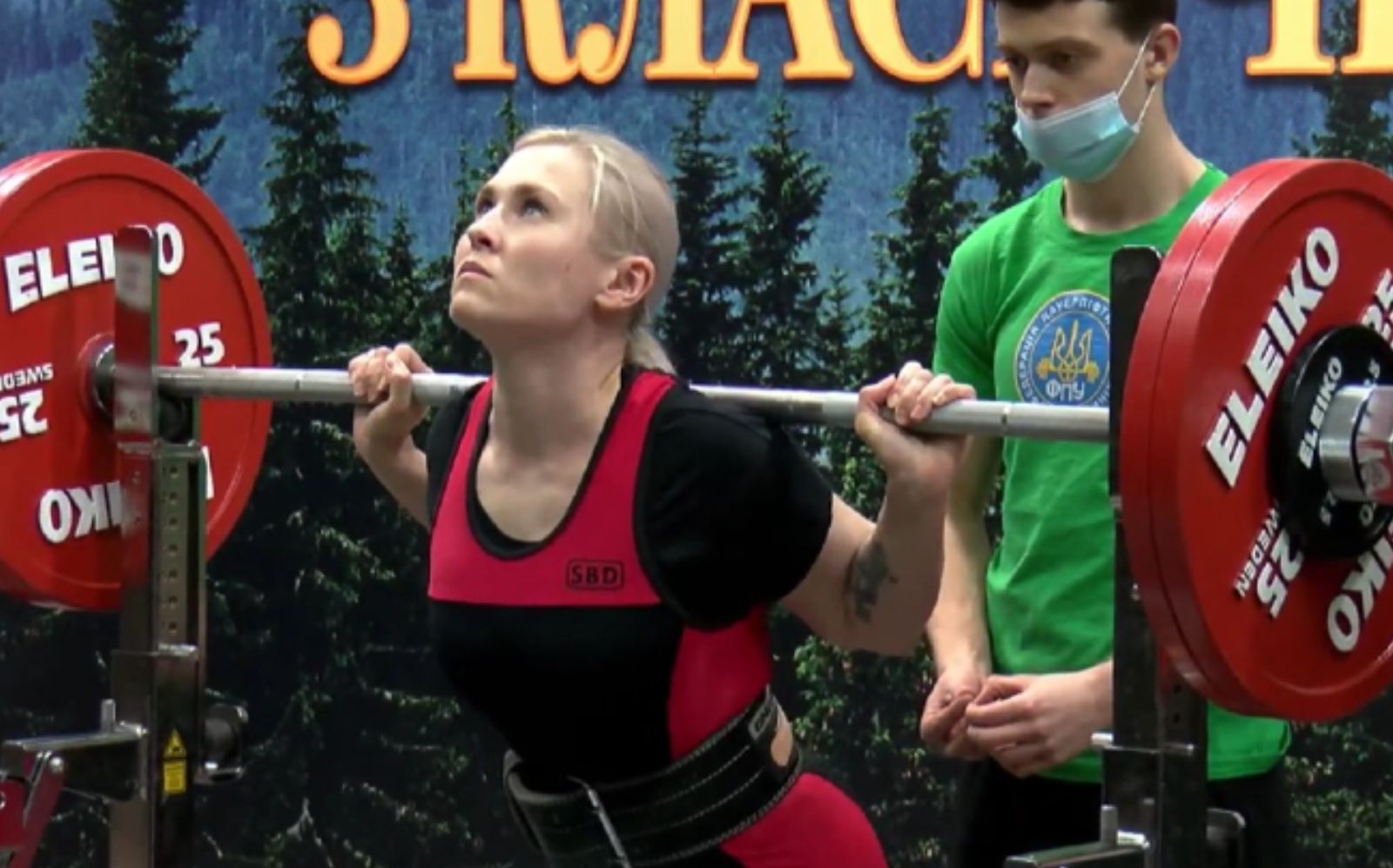The Juggernaut Method has gained a reputation for being one of the most effective strength programs around.
Over the years, many individuals have successfully used the Juggernaut Method to radically transform their strength and overall performance.
The program has been designed for intermediate performers and utilizes an advanced training structure known as block periodization.
This article will outline the components of the Juggernaut Method and allow you to also experience these incredible results.
Juggernaut Training Systems
Before getting into the program, let’s consider how the program came into existence and rapidly grew in popularity and standing.
The program was developed by Chad Wesley Smith, a well-respected strength and conditioning coach from the United States.
Level Up Your Fitness: Join our 💪 strong community in Fitness Volt Newsletter. Get daily inspiration, expert-backed workouts, nutrition tips, the latest in strength sports, and the support you need to reach your goals. Subscribe for free!
As well as being a coach, Chad has also performed on the national and international stage for powerlifting.
At one stage, he held the American record for the squat with a colossal 905 pounds!
He is the owner and founder of Juggernaut Training Systems (JTS) which provides coaching and education for a mix of athletes including powerlifters, weightlifters, and martial artists.
Many of the methods used by JTS appear to be heavily influenced by strength coach Jim Wendler and the legendary powerlifter Doug Young.
JTS ensures that all of the programs they design align with the latest findings in the world of science. As a result, the programs that JTS creates are first class and highly effective.
The Juggernaut Method
The Juggernaut Method (JM) is a training program that has been created for those who consider themselves to be at an intermediate or advanced level.
The program has been designed to run over a 16 week period, however, it is broken up into four “waves” that last four weeks each.
Within each wave, you will find four weekly training blocks that contain four workouts each.
While the majority of strength programs are inflexible and must be followed to a tee, the JM is different.
Rather than a concrete plan that must be adhered to, the JM is more of an open training template.
The purpose of this is to allow each performer to tailor their efforts towards their training goals, preferences, and specific needs.
Although this program has its origins in powerlifting, this flexibility opens the program up for a range of athletes outside of powerlifting.
Although JM will undoubtedly benefit powerlifters, it has been specifically designed for those any athlete who aspires to improve size, strength, speed, and power.
At this point, it should be noted that beginners should not attempt JM. The complexity and intensity of the program will be too high and may lead to overtraining and injury.
Juggernaut Method Spreadsheet
Download the Juggernaut Method & Training Systems Spreadsheet in Excel / Google Spreadsheet below.
Wave and Block Periodization
The periodization structure used is partly why this program is not appropriate for beginners.
In order to simultaneously develop components of fitness, JM utilizes advanced styles of programming known as wave and block periodization.
The program is broken up into four distinct waves with each wave representing a four-week block of training.
For elite-level athletes and lifters, it may be necessary to run each wave for eight weeks to maximize improvements.
There is a ten rep, eight rep, five rep, and three rep wave. As the name suggests, each wave focuses on a particular rep range.
Manipulating the rep ranges in this way allows for multiple fitness components to be developed at the same time.
Studies have shown that heavy lifting and low reps most efficiently develop strength (1) while higher volumes are best for muscle growth (2).
Therefore, the waves used in the program provide the perfect balance for maximizing results.
The purpose of the ten and eight rep wave is primarily to develop muscle size. However, within the eight rep wave, the intensity is increased to prepare you for heavier lifts in the future.
As you move into the five and three rep waves the focus switches to strength building.
While the five rep wave is the middle ground between size and strength, the three rep wave is entirely strength orientated.
Each wave is broken down into four weekly blocks – this is block periodization.
These blocks are known as accumulation, intensification, realization, and deload.
The purpose of the accumulation phase is to use high volumes to build substantial fatigue, develop work capacity, and enhance exercise technique.
In the intensification phase, volume decreases but the intensity of each workout increases significantly in order to cause large adaptations in strength and power.
With the realization phase, volume continues to decrease and intensity peaks to maximize strength and power and optimize athletic performance (3).
Finally, the deload phase involves drastically reducing intensity to allow the body to fully recover from the stress of training and prepare it for the next wave.
Pre-Program Testing
As highlighted, JM is significantly influenced by powerlifter Doug Young. One of the biggest influences is seen in the pre-program testing.
Before starting any training program, it is imperative that some form of strength testing is completed. The results can be used for prescribing training loads and for tracking progress.
The most common method of strength testing for intermediate and advanced lifters is one-rep max tests. This involves lifting as heavy as possible for just one repetition.
Before beginning JM, you will assess or estimate your training max. This is simply 90% of your one-rep max.
The training max was popularized by strength coach Jim Wendler who used it in his 5/3/1 program.
The purpose of the training max is to allow you to complete the prescribed sets and reps with each exercise.
A further benefit of using the training max is that it will allow you to complete high volume work while still using a moderate to high intensity.
This will have a significant impact on the neuromuscular system and cause large adaptations in strength and size.
To figure out your training max, you have two options…
- You could perform a one-rep max test and then multiply the result by 0.9 to calculate your training max
- Alternatively, you could estimate what your one-rep max is based on your training performance and use the above calculation.
If estimating your one-rep max, always be conservative. It is better for you to use a lighter load and perform high-quality movements rather than excessively loading the bar and risking injury.
Once you have your results, input them into the spreadsheet and the program will automatically generate.
However, once the program is up and running you will use a final-set rep max to assess your strength.
Level Up Your Fitness: Join our 💪 strong community in Fitness Volt Newsletter. Get daily inspiration, expert-backed workouts, nutrition tips, the latest in strength sports, and the support you need to reach your goals. Subscribe for free!
This is something that Doug Young utilized in his own training.
After completing the prescribed number of sets and reps, he would finish with one final set. The goal of this set was to perform as many reps as possible.
Based on the results of this test, he would then adjust the weights used for the following week’s training.
The greatest benefit of this method is that it focuses on real performance rather than over-relying on estimates and percentages.
During week three of each wave, you will perform an AMRAP with your final set of each lift.
For each additional repetition that you perform, more weight will be added to the bar for the following week of training.
The results of each AMRAP set must then be input into the new training max calculator to calculate the weights to be used for the next training cycle.
Exercise Selection
The majority of effective strength training programs revolve around four exercises – the squat, deadlift, bench press, and overhead press.
These exercises are classified as compound exercises which means that they utilize many muscles across more than one joint.
Compound exercises have consistently been found to be the best choice for improving muscular strength (4).
Evidently, because the squat, deadlift, and bench are powerlifting exercises, it makes sense to use these as the foundation of strength training programs.
But why the addition of the overhead press?
While it is not a powerlifting exercise, the overhead press can substantially develop pressing strength and upper body size.
Before beginning JM, you must assess your training max for all four lifts, and as the program progresses you will regularly reassess these lifts.
These four exercises form the foundation for JM workouts. There are four workouts to be completed per week with each individual workout focusing on one of the four exercises.
By the end of the week, all four exercises will have been performed once.
Juggernaut Method Workouts
Before starting each workout, Chad recommends a thorough warm-up with the focus being on core activation and mobility.
Performing this type of warm-up has a number of benefits including improving general physical preparedness, reducing injury risk, and diminishing potential restrictions and limitations.
As highlighted earlier, there are four workouts to complete per week. Each workout is devoted to one of the four compound lifts.
The workouts do not have to be done on specific days which gives you the ability to fit training around your schedule.
With that being said, it is important that you aren’t lifting four days consecutively. Adequate recovery days must be incorporated into your training schedule.
The amount of volume that is completed per exercise is dependent on the wave that you are currently on.
Here is The Example Juggernaut Method Training Program

Week 1:
- Monday: Squats—60%x4x10, 60%x10+
- Tuesday: Bench Press—60%x4x10, 60%x10+
- Thursday: Overhead Press—60%x4x10, 60%x10+
- Friday: Deadlifts—60%x4x10, 60%x10+
Week 2:
- Monday: Squats—55%x5, 62.5%x5, 67.5%x2x10, 67.5%x10+
- Tuesday: Bench Press—55%x5, 62.5%x5, 67.5%x2x10, 67.5%x10+
- Thursday: Overhead Press—55%x5, 62.5%x5, 67.5%x2x10, 67.5%x10+
- Friday: Deadlifts—55%x5, 62.5%x5, 67.5%x2x10, 67.5%x10+
Week 3:
- Monday: Squats—50%x5, 60%x3, 70%x1, 75%x10+
- Tuesday: Bench Press—50%x5, 60%x3, 70%x1, 75%x10+
- Thursday: Overhead Press—50%x5, 60%x3, 70%x1, 75%x10+
- Friday: Deadlifts—50%x5, 60%x3, 70%x1, 75%x10+
Week 4 (Deload):
- Monday: Squats—40%x5, 50%x5, 60%x5
- Tuesday: Bench Press—40%x5, 50%x5, 60%x5
- Thursday: Overhead Press—40%x5, 50%x5, 60%x5
- Friday: Deadlifts—40%x5, 50%x5, 60%x5
Week 5:
- Monday: Squats—65%x4x8, 65%x8+
- Tuesday: Bench Press—65%x4x8, 65%x8+
- Thursday: Overhead Press—65%x4x8, 65%x8+
- Friday: Deadlifts—65%x4x8, 65%x8+
Week 6:
- Monday: Squats—60%x3, 67.5%x3, 72.5%x7x3, 72.5%x3+
- Tuesday: Bench Press—60%x3, 67.5%x3, 72.5%x7x3, 72.5%x3+
- Thursday: Overhead Press—60%x3, 67.5%x3, 72.5%x7x3, 72.5%x3+
- Friday: Deadlifts—60%x3, 67.5%x3, 72.5%x7x3, 72.5%x3+
Week 7:
- Monday: Squats—50%x5, 60%x3, 70%x2, 75%x1, 80%x8+
- Tuesday: Bench Press—50%x5, 60%x3, 70%x2, 75%x1, 80%x8+
- Thursday: Overhead Press—50%x5, 60%x3, 70%x2, 75%x1, 80%x8+
- Friday: Deadlifts—50%x5, 60%x3, 70%x2, 75%x1, 80%x8+
Week 8 (Deload):
- Monday: Squats—40%x5, 50%x5, 60%x5
- Tuesday: Bench Press—40%x5, 50%x5, 60%x5
- Thursday: Overhead Press—40%x5, 50%x5, 60%x5
- Friday: Deadlifts—40%x5, 50%x5, 60%x5
Week 9:
- Monday: Squats—70%x5x5, 70%x5+
- Tuesday: Bench Press—70%x5x5, 70%x5+
- Thursday: Overhead Press—70%x5x5, 70%x5+
- Friday: Deadlifts—70%x5x5, 70%x5+
Week 10:
- Monday: Squats—65%x2, 72.5%x2, 77.5%x4x4, 77.5%x4+
- Tuesday: Bench Press—65%x2, 72.5%x2, 77.5%x4x4, 77.5%x4+
- Thursday: Overhead Press—65%x2, 72.5%x2, 77.5%x4x4, 77.5%x4+
- Friday: Deadlifts—65%x2, 72.5%x2, 77.5%x4x4, 77.5%x4+
Week 11:
- Monday: Squats—50%x5, 60%x3, 70%x2, 75%x1, 80%x1, 85%x5+
- Tuesday: Bench Press—50%x5, 60%x3, 70%x2, 75%x1, 80%x1, 85%x5+
- Thursday: Overhead Press—50%x5, 60%x3, 70%x2, 75%x1, 80%x1, 85%x5+
- Friday: Deadlifts—50%x5, 60%x3, 70%x2, 75%x1, 80%x1, 85%x5+
Week 12 (Deload):
- Monday: Squats—40%x5, 50%x5, 60%x5
- Tuesday: Bench Press—40%x5, 50%x5, 60%x5
- Thursday: Overhead Press—40%x5, 50%x5, 60%x5
- Friday: Deadlifts—40%x5, 50%x5, 60%x5
Week 13:
- Monday: Squats—75%x6x3, 75%x3+
- Tuesday: Bench Press—75%x6x3, 75%x3+
- Thursday: Overhead Press—75%x6x3, 75%x3+
- Friday: Deadlifts—75%x6x3, 75%x3+
Week 14:
- Monday: Squats—70%x1, 77.5%x1, 82.5%x4x3, 82.5%x3+
- Tuesday: Bench Press—70%x1, 77.5%x1, 82.5%x4x3, 82.5%x3+
- Thursday: Overhead Press—70%x1, 77.5%x1, 82.5%x4x3, 82.5%x3+
- Friday: Deadlifts—70%x1, 77.5%x1, 82.5%x4x3, 82.5%x3+
Week 15:
- Monday: Squats—50%x5, 60%x3, 70%x2, 75%x1, 80%x1, 85%x1, 90%x3+
- Tuesday: Bench Press—50%x5, 60%x3, 70%x2, 75%x1, 80%x1, 85%x1, 90%x3+
- Thursday: Overhead Press—50%x5, 60%x3, 70%x2, 75%x1, 80%x1, 85%x1, 90%x3+
- Friday: Deadlifts—50%x5, 60%x3, 70%x2, 75%x1, 80%x1, 85%x1, 90%x3+
Week 16 (Deload):
- Monday: Squats—40%x5, 50%x5, 60%x5
- Tuesday: Bench Press—40%x5, 50%x5, 60%x5
- Thursday: Overhead Press—40%x5, 50%x5, 60%x5
- Friday: Deadlifts—40%x5, 50%x5, 60%x5
Juggernaut Method Accessory Work
As highlighted, JM is more of a training template than a full program. This explains why there are no accessory exercises programmed, only primary lifts.
Accessory exercises are important components of training programs as they help to facilitate improvements in strength and size.
Therefore, you have free reign to select accessory exercises. However, it is important that the accessories chosen align with your training goals.
When performing accessories, it is imperative that you make progress from week to week, as you do with the foundational exercises.
Juggernaut Method Books
If you want to learn more about the Juggernaut Method, it is recommended that you read two ebooks by Chad Wesley Smith.
The two ebooks are the “Juggernaut Method 2.0” and the “Juggernaut Raw Squat Handbook”. Both of these books will give you greater insight and understanding of the method and its application.
Other Powerlifting Programs
- nSuns 531 LP Powerlifting Program Guide with Spreadsheets
- The Starting Strength Linear Periodization Program
- The Greyskull Linear Periodization Program (GSLP) Good or Bad?
- Madcow 5×5 Program: The Workout for Strength and Size
- The High Bar vs Low Bar Squat Debate
FAQ’s
Q1) What is the Juggernaut Method?
A) The Juggernaut Method is more of a training template than a rigid training program. The program utilizes wave and block periodization to effectively develop multiple fitness components.
Q2) Is the Juggernaut Method a powerlifting program?
A) While the program certainly has powerlifting elements, it is not necessarily a powerlifting program. It has been designed for all athletes looking to improve strength, size, and power.
Q3) How is the method structured?
A) The plan will take you through four “waves” of training that last four weeks each. Within these waves, you have four workouts per week to complete.
Q4) Who is the program suitable for?
A) The Juggernaut Method is ideal for those of intermediate or advanced experience. Beginners should not attempt to use JM as the volumes and intensities used are too high.
Final Word
The Juggernaut Method is a top-quality, scientifically-based program that utilizes block periodization to maximize muscle development.
Not only is the program the perfect blend of strength, power, and hypertrophy, it is also highly flexible. This allows you to tailor the program closely to your needs, goals, and preferences.
References:
1 – Bj, Schoenfeld; Md, Peterson; D, Ogborn; B, Contreras; Gt, Sonmez (2015 Oct). “Effects of Low- Vs. High-Load Resistance Training on Muscle Strength and Hypertrophy in Well-Trained Men”. Journal of strength and conditioning research. PMID 25853914.
2 – SCHOENFELD, BRAD J.; CONTRERAS, BRET; KRIEGER, JAMES; GRGIC, JOZO; DELCASTILLO, KENNETH; BELLIARD, RAMON; ALTO, ANDREW (2019-1). “Resistance Training Volume Enhances Muscle Hypertrophy but Not Strength in Trained Men”. Medicine and Science in Sports and Exercise. 51 (1): 94–103. doi:10.1249/MSS.0000000000001764. ISSN 0195-9131. PMC 6303131. PMID 30153194.
3 – Lorenz, Daniel; Morrison, Scot (2015-11). “CURRENT CONCEPTS IN PERIODIZATION OF STRENGTH AND CONDITIONING FOR THE SPORTS PHYSICAL THERAPIST”. International Journal of Sports Physical Therapy. 10 (6): 734–747. ISSN 2159-2896. PMC 4637911. PMID 26618056.
4 – Paoli, Antonio; Gentil, Paulo; Moro, Tatiana; Marcolin, Giuseppe; Bianco, Antonino (2017-12-22). “Resistance Training with Single vs. Multi-joint Exercises at Equal Total Load Volume: Effects on Body Composition, Cardiorespiratory Fitness, and Muscle Strength”. Frontiers in Physiology. 8. doi:10.3389/fphys.2017.01105. ISSN 1664-042X. PMC 5744434. PMID 29312007.











Hello,
Great article. I want to ask about the cases when you do not have enough free days during the week. Can you sometimes work out 2 or 3 days a week. For example Bench Press and Squat one day and rest /rest, rest/ and Shoulder Press and Deadlift on the next day. Or Bench Press, rest, Squat, rest, Shoulder Press and Deadlift, rest, rest and so on.
And when you have the opportunity to continue training 4 days a week so that you do not do more than one exercise in the same day..